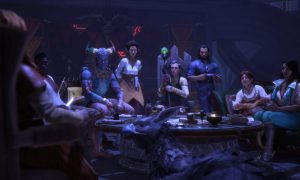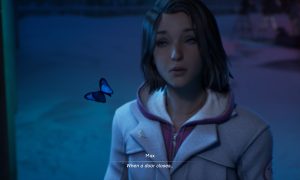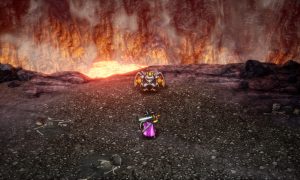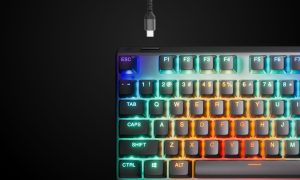 Americans love World War II–our version of it, anyways. We delight in watching movies and television shows depicting honest farmboys picking up their rifles and storming across the Atlantic to solve all of Europe’s Nazi-related problems. Relic Entertainment’s 2006 strategy game Company of Heroes fit right into that milieu, using a brilliant combat engine and incredible audio-visual production to cover the same notes of reverence and heroism we’ve seen ever since Saving Private Ryan hit the big screen. It’s easy to see the appeal of this tale of a noble time when the US got on its shining horse and saved the world from tyranny. It’s a great story. There’s just one problem: it isn’t true.
Americans love World War II–our version of it, anyways. We delight in watching movies and television shows depicting honest farmboys picking up their rifles and storming across the Atlantic to solve all of Europe’s Nazi-related problems. Relic Entertainment’s 2006 strategy game Company of Heroes fit right into that milieu, using a brilliant combat engine and incredible audio-visual production to cover the same notes of reverence and heroism we’ve seen ever since Saving Private Ryan hit the big screen. It’s easy to see the appeal of this tale of a noble time when the US got on its shining horse and saved the world from tyranny. It’s a great story. There’s just one problem: it isn’t true.
[singlepic id=13827 w=320 h=240 float=left]In actuality, many other nations played significant roles in the war—Relic paid homage to their Canadian roots by including the British Commonwealth in the expansion Opposing Fronts—but the single most important faction was the Soviet Union. The USSR bore the brunt of the German army, losing more men at the Battle of Stalingrad alone than the United States lost on all fronts in the entire war. The Great Patriotic War was without question the largest clash between two armed nations in the history of our world and it is there, in the forests of Poland and the steppe of Russia, that Relic chose to return to the Second World War with Company of Heroes 2.
The war in the east was legendarily barbarous. While surrendering troops in the west could reasonably expect safe treatment, prisoners on the Ostfront were regularly executed, and those not killed outright were deported to gulags and konzentrationslager for years of abuse. Likewise, the plot that drives the single-player campaign in Company of Heroes 2 is markedly different than that of its predecessor. In the 2006 Company of Heroes the bad guys are—obviously—the Nazis. The conflict revolves around liberating Normandy as part of operation Overlord. In contrast, the central conflict in Company of Heroes 2 is between Lev Isakovich and his Soviet superiors. Each mission is recounted from a post-war gulag as Isaokovich attempts to explain how he became disillusioned with the USSR. It’s fairly effective storytelling and the tale is well told, not shying away from the brutal treatment of Soviet troops by their officers. That said, it’s hardly a work of stunning originality.[singlepic id=13826 w=320 h=240 float=right]
The missions themselves offer a fairly wide range of gameplay, while generally following the historical progress of the war. Early scenarios hinge on the defense of small towns to protect retreating tank columns and troop transports, culminating in a harrowing last stand on the outskirts of Moscow. I have to say, the satisfaction of that moment when you’re given a bunch of tanks and finally allowed to go on the offensive after two hours of fighting retreats is nearly indescribable. The rest of the campaign has you assaulting German strongholds or encircling an isolated Nazi-infested town before massacring its defenders. The only real misstep is a combined stealth/escort mission near a concentration camp in Poland that has very little margin for error. I like what Relic was trying to do with this mission, but losing 35 minutes of play to a single shot from a hidden sniper is incredibly frustrating.
While I generally enjoyed the campaign, I was a bit confused at the battles Relic chose to highlight. Several of the most important battles of the Eastern Front are completely absent. I was shocked when the plot passed over the Battle of Kursk with barely a mention. Even the major battles that are in Company of Heroes 2 seem oddly diminished. There are no fewer than three missions in Stalingrad, but none of them ever seem to capture the scale of the event–the only battle that felt genuinely massive was the final assault on Berlin. I expect we’ll see other battles in DLC or expansion packs, like we did with Opposing Fronts and Tales of Valor, but we’ll have to wait and see.
When it comes to gameplay mechanics, Relic made a great choice by essentially changing nothing. It wasn’t broke in 2006, and there’s no need to fix in now. Each match pits you against another player (or AI) as you either secure special “victory towers” long enough to reduce your opponent’s point total to zero or completely erase them from the map. To do this you’ll need to secure resource depots and maintain lines of supply. When enemy forces meet, the butcher’s bill is determined by unit quality, unit facing, and the proper use of cover. Flanking is always a good idea, as nearly every unit is vulnerable from the sides or from behind.
[singlepic id=13828 w=320 h=240 float=left]That’s not to say there’s no new content at all, though. The Eastern Front was known for its miserable conditions, and “General Winter” adds a few new wrinkles to gameplay. Leaving the roads in heavy winter snows brings movement speeds to a crawl, making control of the highways and trails especially important. Frozen rivers can be crossed, but a well placed shell can shatter the ice, drowning infantry and tanks alike. Occasional blizzards reduce line-of-sight to nothing, and force infantry to huddle around fires lest they freeze to death. These all add extra options and risks for commanders to consider when fighting in the snow. The line of sight mechanic is also refined, making ambushes much harder to spot as units can hide behind corners.
While the addition of winter warfare and the refined line of sight add a bit of depth, Relic failed to deliver on the one change I had hoped for: the inclusion of WASD camera controls. I am completely baffled that I have to use the arrow keys to scroll around the map in 2013. This is compounded by the fact that nearly all of your units’ special abilities are mapped to the D, E, T, and V keys—easily in range of a standard WASD mouse-keyboard setup. Try quickly switching between a WASD setup for access to those keys and then back to the arrows for camera control, I dare you. I’m sure serious players would tell me it’s better to use the mini-map instead of scrolling around, but I like what I like. Outside of that, the interface and controls are just as excellent now as they were in 2006.
One of the incredible things about Company of Heroes and its sequel is the way the map evolves over the course of the battle. The houses you use as strongholds against machine gun fire will come crashing down on your soldiers’ heads once enemy mortars zero in. Walls and fences that confounded your armored cars and half-tracks are crushed beneath the weight of tanks, while mortar and anti-tank rounds dig out shell holes your infantry can use for cover.[singlepic id=13824 w=320 h=240 float=right]
When combined with the sheer destructibility of the world, the beautiful graphics engine really helps bring the battles to life. When it first launched back in 2006, Company of Heroes fundamentally changed what I thought PC strategy games could look like. This second outing is much more evolutionary than revolutionary–a refinement of the older title. That said, the game looks spectacular. Artillery shells burst in clouds of dirt and flame and machine-gun rounds kick up dirt around the soldiers under fire, while the soldiers themselves crawl around attempting to find some kind of defilade. Higher settings really ratchet up the detail and fidelity of the effects, but even playing on lower graphics settings you can still appreciate the effort Relic put into visuals. Weapons, tanks and other war materiel are all lovingly modeled. At first, it can be a bit difficult to quickly distinguish between the different tanks if you aren’t a history buff, but you’ll quickly learn to spot the differences between a Panzer and a Panther.
One of the best aspects of the entire series is the audio, and Company of Heroes 2 is an aural feast. Even when nothing else is happening tank treads creak, half-track engines roar, and idle men chat about their surroundings. In combat, troops shout confirmation of your orders over the buzzing of an MG42 or the thundering crash of a bursting artillery shell. The music is also excellent, which more than makes up for the lackluster voice acting and phony-sounding accents.
Though I’m sure more will be released in the future as DLC, the two factions included in Company of Heroes 2 are the Wehrmacht and the Red Army. The Nazis are essentially unchanged from Company of Heroes, using specialized units to establish a strong defense until they can bring their powerful armor into the fight to deliver the coup de gras. The Soviet troops are much less specialized, and you’ll end up relying on cheap infantry to absorb the brunt of German fire while better units flank around to attack. More than once I found myself mimicking Soviet doctrine by sacrificing conscripts to my own mortar or artillery fire if it meant the chance to destroy a group of expensive German panzergrenadiers or half-tracks. I tell myself they were expendable and try not to see their faces when I’m struggling to sleep at night. It doesn’t help.
[singlepic id=13829 w=320 h=240 float=left]Company of Heroes was one of the very few games I dedicated myself to playing multiplayer, but there really wasn’t much to keep me involved in the original as I never really had any feedback on your game except your win/loss record and a meaningless “rank.” Company of Heroes 2 changes all of that. Not only are your actions and statistics tracked in excruciating detail, you’re rewarded for your time in the game. Use a certain ability 100 times, and you’re rewarded with a token that will increase your infantry’s rate of fire by a small amount. You can only equip three of these tokens at a time, but they allow you to personalize your army a bit. You can also unlock special commanders, granting you unique ability trees, bonuses, and special paint schemes for vehicles. The matches themselves range from tight 1v1 skirmishes to massive 4v4 battles. Honestly, if you’re at all interested you should just download the open beta on Steam. It’s free for the weekend of 6/21/2013.
Users who pre-order Company of Heroes 2 before it launches will be given access to some additional content in the “Theater of War” package, though I imagine it will probably be on sale as DLC soon after launch. Due to time constraints, I asked Commisar Sam to have a look at it.
Theater of War is a game mode included with Company of Heroes 2 that focuses both on solo challenges–where players are pitted against overwhelming odds against tough AI opponents–as well as co-op multiplayer matches. Prior to this, I had spent much of my time playing skirmishes in the Open Beta against the staunch forces of the Wehrmacht, but when I gained access to Theater of War with the full version, I was pleasantly surprised by the wealth of historical detail the developers had poured into every mission; they clearly had a passion for their game’s subject material. Theater of War allows the player to rehearse scenarios that they would typically encounter online, or even during the campaign, but this inclusion definitely has the intent of honing your battle skills when facing the most cunning of all opponents–another dude at his computer.
Solo challenges force you to conceive of clever ways to outplay the enemy using meager resources and a modest army, while co-op lets you link up with a friend to work on your wartime communication before trying it out in a more competitive environment. There are also a wide variety of settings for outpost defense missions, where you must fend off wave after wave of diabolically resilient German forces. Three levels of difficulty further allow you to customize the experience, although caveat emptor should you wish to try Captain or General difficulty – the AI does not mess around on higher settings, and sometimes the back of the Wehrmacht will simply refuse to break (or even weaken). I felt that the computer advantage got a little out of hand at times, leading to some harried moments of frustration as I watched my base get trampled, but hey, it’s a learning experience–I like to think I’m a better man for all that. Such challenges are possible to overcome, once you improve your “patience” and “planning” special abilities a bit, and a good deal of the fun comes from seeing how wily you can get in order to beat the Nazis.
I found this to be a tremendously detailed and nuanced addition to the game that lends a level of depth and quality that certainly wasn’t lacking from the original title per se, but it’s another example of Relic outdoing themselves, when it hadn’t even occurred to most of us that there might be room for improvement in this regard, i.e. the inclusion of multiplayer training scenarios. It’s an imaginative way to drill and prepare for the trials and tribulations of online battle, and even when faced with the wide variety of game modes that the full version has to offer, I found myself drawn to Theater of War more often than not, which speaks volumes.
Like nearly any other modern strategy game, Company of Heroes 2 includes the ability to save and view replays. While the system isn’t quite so robust as you’d find in Starcraft II, Relic makes up for it by including some pretty awesome integration with Twitch.tv. Players can log into their Twitch.tv accounts from the main menu, and then live-stream their matches—even give live commentary. I’ve never been one to watch streaming games or “Let’s Play” videos, but I’ll probably have to give this a shot when Company of Heroes 2 launches—if only to learn the secrets and build orders.[singlepic id=13825 w=320 h=240 float=right]
At this point, I’m running out of superlatives, so it’s probably time to start wrapping up this review–but really, what is there to say? The only flaws I can find in Company of Heroes 2 are nit-picks of the lowest order. Relic has taken one of the greatest strategy games of the last 10 years and given it a brilliant new coat of paint while subtly refining the rock-solid mechanics and gameplay. What more could you ever ask of a sequel?
[edit: Company of Heroes was launched was 2006, not 2009. Error has been corrected.)
Addie grew up near Detroit. After studying Cell Biology at the University of Michigan and spending a year looking into microscopes, Addie decided to volunteer--playing video games. hobbies run from gaming to music (voice, bass, guitar) to rugby. Addie is a strong supporter of indie and low-cost gaming, an area she thinks is underserved by the media.

See below for our list of partners and affiliates:

























